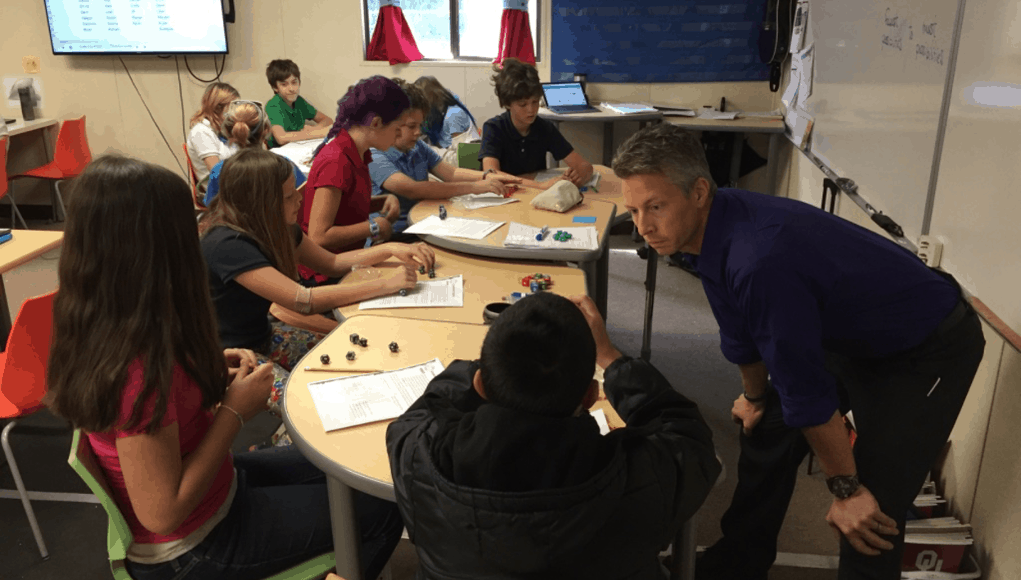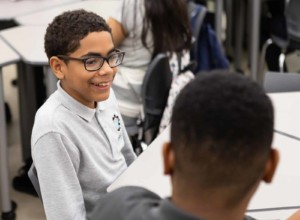Next Generation School Design

There’s never been a better time to create a powerful learning environment–and the task has never been more important. But it also has never been more complicated.
A diverse group of educators–from preschools to colleges across north Africa and the middle east–gathered at the Digital Education Show in Dubai (#DigEdME) recently for a Getting Smart school design workshop. We spent four hours working on four topics: new models, goals, tools and tips.
1. New School Models. The best way to learn about new learning models is to visit schools. In the workshop, we made a quick virtual tour of some of our favorite elementary and secondary schools. Of particular note, we discussed blended, personalized SEL at Thrive (featured image), Bay Blends and project-based learning at Katherine Smith School and Bulldog Tech (don’t miss the podcast).
We reviewed the Christensen definition of blended learning options and discussed how iNACOL describes the relationship between personalized learning and the shift to competency-based learning. We reviewed the two dozen important decisions that new schools entail.
New School Design Decisions
|
2. Goals, Strategy, Timeline & Model. Defining learning goals starts with community conversation about what graduates should know and be able to do. We discussed large-scale examples of creating new graduation profiles including Houston and El Paso, and the NGLC MyWays framework (as well as some non-traditional approaches).

The conference confirmed that confines (real or perceived) of standardized testing and college entrance requirements where a global inhibitor to developing more student-centered education. Schools need to be responsive to their stakeholders (e.g., get graduates ready for college) but they also need to continue to test what career and civic readiness entail. School visits and community conversations may yield more room to innovate than was perceived (see the Singapore American School case study).
We discussed ways that school and system heads could balance improvement and innovation.
|
Competency-Based Career Education College of the North Atlantic-Qatar is an interesting case study. It serves as the country’s CTE partner offering 30 diploma programs including engineering, business, health, IT. Blended learning strategies and a 12:1 staffing ratio help address the significant language challenges that two-thirds of the population bring to school. The two and three-year diploma programs are driven by employer defined competencies including academic, technical and employability skills. To ensure demonstrated mastery, midterm and final assessments are blind scored. Competencies are tracked in D2L Brightspace and a portfolio demonstrating employability is developed. Many students are sponsored by companies with regular check-in sessions and work-based learning opportunities. |
3. Platforms, Content, Devices & Talent. We reviewed and compared learning platforms acknowledging that none are likely to do everything a school or network is seeking.
We discussed access and production devices and how fast Chromebooks had closed the gap in the US. Some participants were enthusiastic about the Microsoft Surface tablet.
We discussed how great networks (like Summit) and districts (like Kettle Moraine) approach teacher development.
4. Opening Great New Schools. We unpacked tips for opening great new schools including:
- Getting the culture right
- Creating beautiful learning spaces
- How to open a makerspace
Workshop participants observed:
- It’s all about people
- We need to get out and visit innovative schools
- We should hold community meetings to discuss what graduates should know and be able to do
- There is no one best solution but an expanding number of options
- We need to balance improvement and innovation
- We need a “dust-free strategy” that is frequently updated
- Next gen learning can be phased in
- We always need a “Plan B” for when technology fails
The Getting Smart team supports next generation school design and coaches new schools. [email protected] would be happy to discuss your project.
For more, see these reports:
- Preparing Teachers for a Project-based World
- Preparing Students for a Project-based world
- Blended Language Learning
- Microcredentials for teacher development
- Smart Series Guide To EdTech Procurement
- Blended Learning Implementation Guide 3.0
Stay in-the-know with all things EdTech and innovations in learning by signing up to receive the weekly Smart Update. This post includes mentions of a Getting Smart partner. For a full list of partners, affiliate organizations and all other disclosures please see our Partner page.






gary gruber
New school designs are important to collect, review, evaluate, see what's working and why. So much good information to be shared and applied. Thanks for this. Here is my take on a different model and I have a longer, more detailed description for anyone truly interested.
http://garygruber.com/a-new-school-model-the-teaching-hospital/